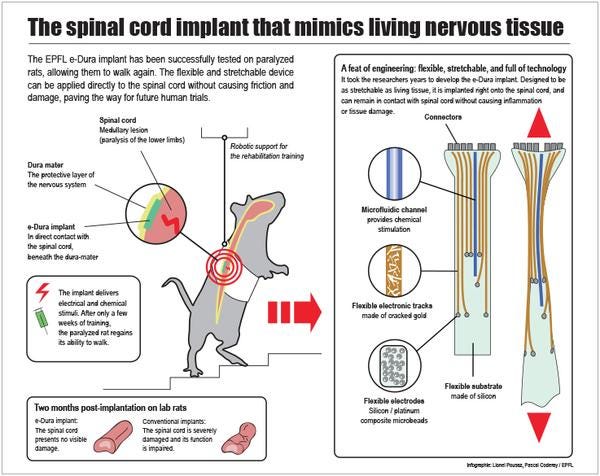Novel Implant Helps Paralyzed Rats Walk
January 12, 2015
Paralyzed rats can walk on their thanks to a combination of electrical and chemical stimulation, thanks to research performed in Switzerland.
Professors from the Swiss Federal Institute of Technology, known as EPFL, designed a specific implant that can be placed on the surface of the brain or spinal cord that can closely imitate the mechanical properties of living tissue. The e-Dura implant, as it's known, can simultaneously deliver electrical impulses and pharmacological substances, while minimizing the risk of rejection or damage to the spinal cord.
|
Typically these "surface implants" have been difficult to implement because they cannot be applied long term to the spinal cord or brain beneath the nervous system's protective envelope known as "dura mater." The reason for that is that when nerve tissues move or stretch, they rub against these devices. Over time, this repeated friction causes inflammation that can result in scar tissue buildup, and eventually rejection.
Designed to be both flexible and stretchy, the e-Dura implant can be placed beneath the dura mater, directly onto the spinal cord. The implant was specifically designed with remarkable elasticity, along with the potential for deformation in an attempt to make it identical to the living tissue surrounding it. This helps reduce friction dramatically, avoiding significant inflammation.
When researchers implanted the device into rats, the e-Dura prototype caused no tissue damage, nor was it rejected after two months of observation. Traditional surface implants in the past have caused significant nerve tissue damage during this period of time, making the e-Dura implant a possibly viable treatment option for spinal cord injuries in the future.
The researchers at EPFL have spent many hours working on alternative treatment options for spinal cord injuries, as they search for ideal therapies that are both effective and sustainable. Just last year they developed a method to precisely control the motor functions of paralyzed rats through a computer using electrical stimulation. Some of their findings contributed to the development of the e-Dura implant, as they continue to work with paralyzed rats before making the leap to human trials.
The researchers tested the device prototype by combining electrical and chemical stimulation to these paralyzed rats. Not only did the implant improve their biocompatibility, but it also enabled the rats with the ability to walk on their own after only a few weeks of training. The implant can also be used to monitor electrical impulses from the brain in real time, allowing researchers to interpret precisely the rat's motor intentions before they were translated into movement.
For now, the e-Dura implant has been primarily used in spinal cord injury cases involving paralyzed rats, but researchers believe the potential for these surface implants could be significant, specifically in the treatment of epilepsy, Parkinson's disease, and other methods of pain management. Researchers hope to begin clinical trials in the near future as they prepare to move the prototype toward commercialization.
Refresh your medical device industry knowledge at MD&M West, in Anaheim, CA, February 10-12, 2015. |
Kristopher Sturgis is a contributor to Qmed and MPMN.
Like what you're reading? Subscribe to our daily e-newsletter.
About the Author(s)
You May Also Like



